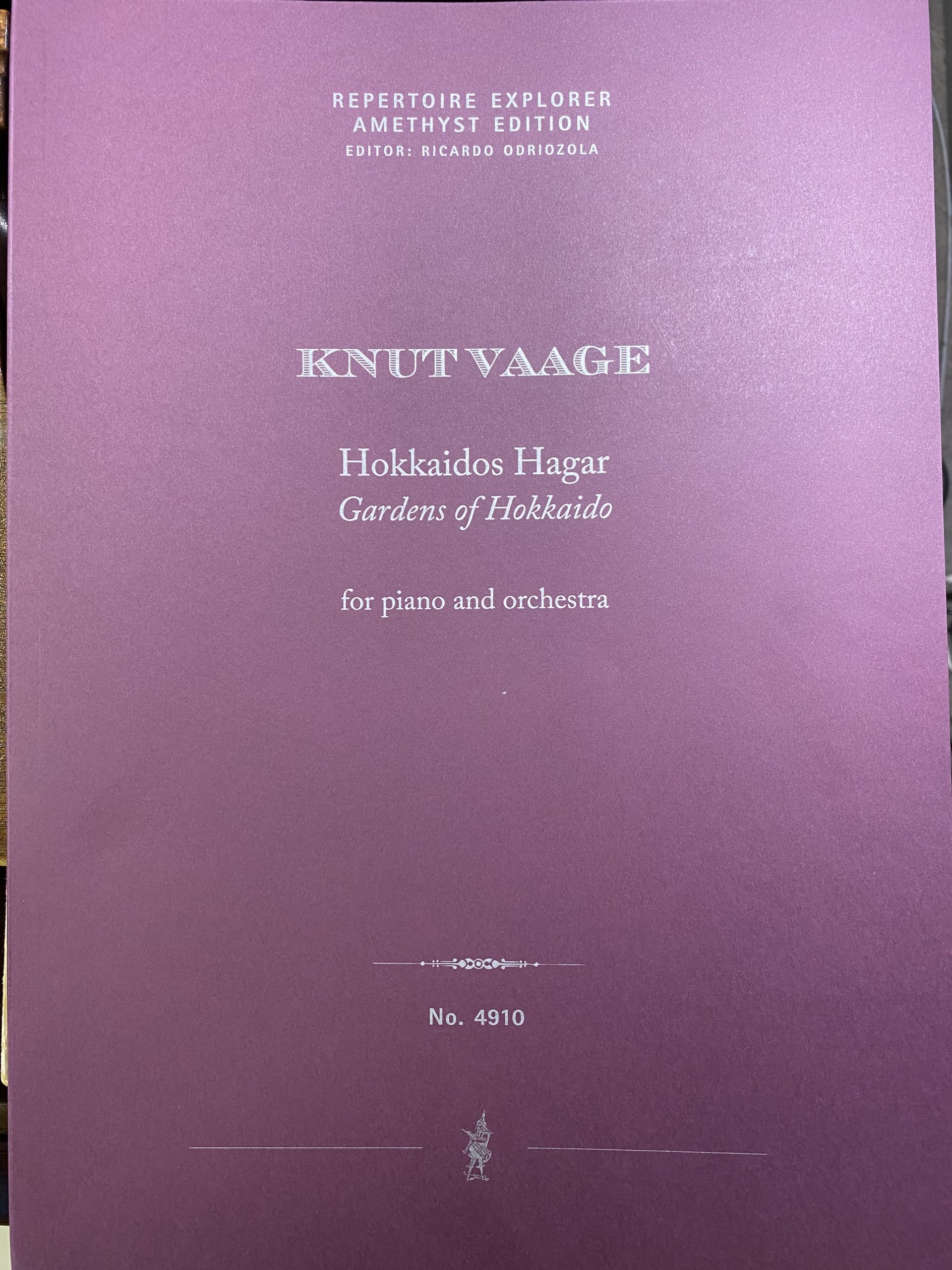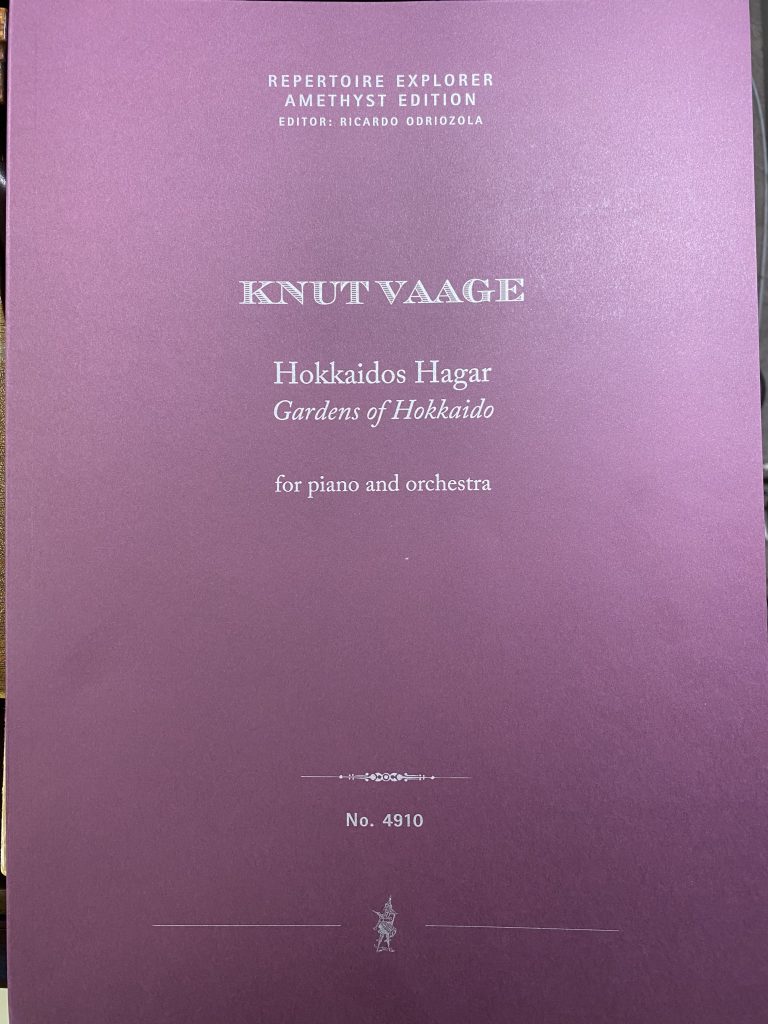
18 Jul GARDENS OF HOKKAIDO PUBLISHED AT MUSIKPRODUKTION HÖFLICH IN MÜNCHEN

Knut Vaage – Hokkaidos hagar (The Gardens of Hokkaido) for piano and orchestra
First performance: 6. October 2005
Grieghallen, Bergen
Einar Røttingen, piano
Bergen Philharmonic Orchestra
Ingar Bergby, conductor
Hokkaidos hagar was conceived in 2001 during the concert tour of Japan in which Trond Sæverud and Einar Røttingen premiered Vaage’s work “In Between” for violin and piano (mph 4618).
Like its possible forebear, Manuel de Falla’s Nights in the Gardens of Spain, The Gardens of Hokkaido places the piano in a concertante role, rather than as the soloist of the Classical and Romantic traditions.
In performance, the pianist is meant to sit in the middle of the orchestra, facing the audience. The ensemble is, in fact a double orchestra placed symmetrically around the pianist.
In connection with the premiere of the work, which was broadcast live to several countries in Europe, Vaage gave a spoken introduction. In it he mentioned the main commissioner of the piece, Einar Røttingen, whose tireless work for the promotion of contemporary Norwegian music in his circle Vaage emphasized. He went on to remark that the idea for the piece was born out of a conversation between him and Røttingen during a 12 hour long train journey from Sapporo to Tokyo that took place in the aforementioned concert tour. Hokkaido is Japan’s most northern island. Vaage points out, however, that Hokkaidos hagar is not program music but that it rather reflects the composer’s encounter with the landscape, people and culture of Japan. This permeates, in the composer’s mind, the timbral aspect of the composition. As Vaage explained
In my mind’s eye I can still see glimpses of pine forests, mountains and the ocean – and the bright light that dispelled my claustrophobia from travelling through the world’s longest tunnel under the sea.
The composition of the work went on in a very organic way, as it involved several workshops with both soloist and orchestra. This gave all the musicians involved a sense of ownership. Vaage further expounds
Given the chance to write for piano and orchestra, it was impossible to resist the temptation to refer to Edvard Grieg’s A minor Concerto. However, Grieg’s monumental opening with its characteristic descending motif is here reduced to a frail descending phrase from the back desk of the second violins, ending in the first appearance of the piano, a single staccato A. Here the similarity ceases, as far as I am aware.
Hokkaidos Hagar is composed as a single movement which develops in a kind of free form. It is composed inwards from both ends: active material moves forwards from the start, while the calm thematic material is composed from the end, flowing in the opposite direction towards the beginning of the piece, like two hands reaching to grasp each other without totally succeeding.
It has been important for me in this piece to concentrate on the peregrinations of sound in space, focusing on the orchestra’s ability to create three-dimensional textures. The underlying idea is that the orchestra, as a small community, consists of numerous individuals, all of more or less equal importance, producing sound either in harmony or in contrast to one another.
Based on these ideas the orchestra is divided symmetrically into two, with the pianist in the centre, the percussion in a cluster behind, and on either side the harp and celesta, each with its practically identical string orchestra,
When there is a small solo part, it never comes from a single musician, but rather in dialogue or echo. This antiphony permeates the entire work. The score is planned so that the sound constantly wanders, either between the soloist and the musicians in the orchestra, or spreading from the string octet at the front of the string section, eventually reaching the entire orchestra. This gives the work an aspect reminiscent of chamber music, in which more musicians than usual participate with solo contributions as an integral part of the orchestral texture.
The Gardens of Hokkaido is a feast of tone colours. Although massive, loud passages do occur in the work, there is a sense of the impersonal about them. They do not appear threatening or aggressive, but rather as a dispassionate representation of the mechanical noise produced by a vehicle travelling at various speeds. The ever changing visual impressions from both sides of the train – when it travels in the light – can also be sensed.
Vaage’s chosen method of composition – forwards and backwards from either end of this work – is fascinating and can also be perceived after repeated listenings. The very characteristic pentatonic motif at the end of the work (measure 638, with upbeat) is insinuated twice earlier in the piece (mm. 313 and 556 with upbeat)
Elsewhere, bursts of activity are followed by short oases of reflection. One such passage occurs at m. 238 and ff. accompanied by bird sounds. It uses a melody and harmonic progression reminiscent of one of the main musical ideas of the earlier mentioned In Between. Often one can perceive strands of tonal harmony peering through the sonic mist. Through much of the work, one may sense an ongoing dialogue between the mechanical and the organic. The former definitely gains the upper hand at m. 366 and ff, with the beginning of the accelerating train motif. While the orchestra mostly functions as either e mirror to the piano as a moving background, with this overpowering motif it manages to drag the pianist along with it. It is a memorable, if not exactly pleasant, section of the work. As such it stands in sharp contrast to the profoundly calm – and equally memorable – pentatonic motif that dominates the latter part of the work (m. 638). This motif is complemented by a tail end whose rhythm and shape may bring to mind the music of the Second Vienna School (mm. 672-73). The wispy flute and marimba upbeat at the end of m. 669, after the near silence of the whispering timpani and harp between mm. 666 and 669, makes for a very affecting moment. It is followed by one last surge of activity and the unassuming remnants of the bustle that permeated the first two thirds of the work before the music ends in deep calm.
The Gardens of Hokkaido is a worthy and original addition to the vast repertoire for piano and orchestra. It requires considerable virtuosity and ensemble skills from all the players, not least the pianist. Although the music can appear overpowering at times, there is much tenderness and sensual beauty lurking close to the surface, often coming through as a gust of fresh air. The work appears on the CD “GARDENS OF HOKKAIDO”, ACD 5072.
Ricardo Odriozola, 26. May 2024

Sorry, the comment form is closed at this time.